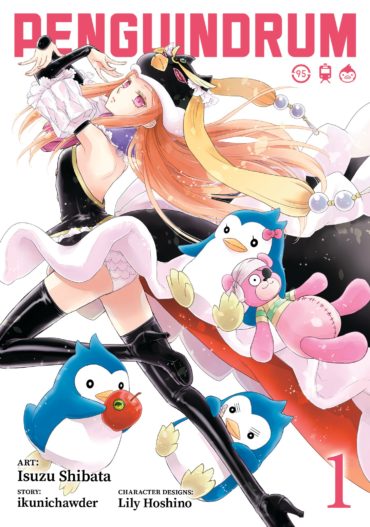Penguindrum Volume 1 Review
The original anime version of Penguindrum came out nine years ago. It was created by Ikuhara Kunihiko, who directed such famous series as Revolutionary Girl Utena, Yurikuma Arashi and, most recently, Sarazanmai. This manga adaptation was published between 2013-17, with Ikuhara listed under the name “ikunichawder”. The first of these books, adapting the first six episodes, is now available and is a good way to access the story if you – like me – failed to catch it all first time around. From what little I have been able to see of the anime, however, it seems that some scenes are ordered differently in the manga than they are in the anime, but the translation by Beni Axia Conrad seems to fit with the translation of the original TV version.
The story follows the three Takaura siblings: playboy older brother Kanba, more responsible younger brother Shoma, and youngest sister Himari. Himari is suffering from a terminal illness, and to help cheer her up, all three of the siblings go to the aquarium to see the penguins. While there, Himari is given a penguin hat as a gift, but then she collapses and dies while wearing the hat. The brothers mourn their loss at the hospital, but suddenly Himari sits upright in the bed and begins to talk completely out of character, until the hat slips off and she returns to her normal self, still alive.
Later the trio find that their house has been occupied by three penguins that only they can see. Whenever Himari puts on the penguin hat, her personality changes. It appears that when she wears the hat, her body is taken over by some being from another world. She exclaims to Kanba and Shoma, “I hereby inform you that you two, who shall amount to nothing, will acquire the Penguindrum”, and if they fail to do so then Himari will die again.

She does not explain what the Penguindrum is, but tells them to follow a girl called Ringo Oginome who appears to have it. Ringo turns out to be a schoolgirl who spends most of her time stalking Kanba and Shoma’s science teacher Tabuki. Ringo also has in her possession her late sister’s diary, which may well have a connection to the Penguindrum.
As far as this opening volume is concerned, the art comes across as better than the writing. I like the way that the flashbacks are told, with each one being prefaced with what appears to be a digital display board in a train station (the chapters are all referred to as “stations”), while the transformation Himari goes through evokes memories of magical girl sequences. Artist Isuzu Shibata remains faithful to the original character designs by Lily Hoshino.

The writing meanwhile is at times confusing, primarily because the story has yet to mention what the “Penguindrum” is, which is admittedly understandable as it is the key element to the story. While it is currently frustrating not to know what it is, it makes you more desperate to find out. Also, some readers might be put off by some of the fan service that appears in the story, which partly comes about due to Kanba’s attitude to women, where he briefly dates one girl before moving quickly to the next one. However, some elements of the story such as the way the transformed Himari deals with the brothers, or the strange behaviour Ringo exhibits when stalking are entertaining. The first volume also ends with a key revelation that certainly makes the plot move forward.
So far, the first edition of Penguindrum is a mixed bag, but the way the story is being told does tempt me into reading at least the next volume, especially given Ikuhara’s previous work.


